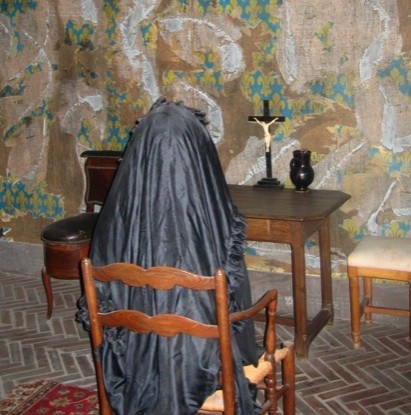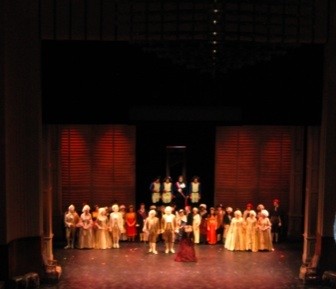John Corigliano's Ghost of Versailles
Manhattan School of Music Brings the Ghosts to Life
By: Susan Hall - Apr 27, 2012
The Ghosts of Versailles
By John Corigliano
Libretto by William M. Hoffman
Conducted by Steven Osgood
Directed by Jay Lesenger
Steven Capone (Scenic Designer), Daniel James Cole (Costume Designer), Lee Fiskness (Lighting Designer), Francis Patrelle (Choreographer).
Cree Carrico (Marie Antoinette), Gideon Dabi (Beaumarchais), Brett Sprague (Count Alamaviva), Nickoli Strommer (Figaro).
Manhattan School of Music
Opera Theater
John C. Borden Auditorium
New York
April 25, April 27 and April 29
A smashing production of John Corigliano’s The Ghosts of Versailles is being mounted at the Manhattan School of Music. This subversive opera pricks our understanding of history, of stories and of opera itself. Early on, the audience knowingly laughed when it was suggested on stage that opera was boring. There was nothing boring about the proceedings in uptown Manhattan.
In grand opera style the stage was packed with characters and action. Long before Sofia Coppola and Lady Antonia Fraser discovered that in fact Marie Antoinette did not say “Let them eat bread,” and was a much more interesting character than the French terrorists imagined. John Corigliano and his librettist set out to correct our picture of the French Revolution and other things.
Cree Carrico as Marie dominates the stage, wishing to re-write history and her fate. In a voice of many colors, she dismisses the King and turns to none other than Pierre Beuamarchais to save her. Among his many talents, the real Beaumarchais was a seducer of rich and royal women. Yet Marie falls to his charms mainly because he may be able to keep the axe from falling. Gideon Dabi as Beaumarchais creates a play within the opera, like the Composer in Strauss’ Ariadne. He steps inside the action too. Everything was possible for Beaumarchais.
Corigliano and his librettist William M. Hoffman, honor Beaumarchais for his contributions to opera, as the author of the underlying plays that gave us the delicious Marriage of Figaro and Barber of Seville. His third play The Guilty Mother is less well known, but incorporated in Ghosts.
Mixing memory and desire, Corigliano sets his opera in Versailles, in Marie’s home, in her prison cell where she prayed as she awaited beheading at the Conciergerie, on a site where a tiny chapel now stands. As time is mixed, the brilliant stage director Jay Lesenger creates three zones on stage, and also the area in front of the orchestra pit. The misty ghosts of pre-Revolutionary French royalty come to life stage front. In the middle zone various new operatic scenes are enacted, often featuring another star of this star-studded production, Nickoli Strommer, as Figaro in various guises. A lusty baritone with infinite variety as an actor, Strommer counterpointed the march to Marie’s execution with turns as a Turkish seducer as well as Susanna’s husband.
Three flat panels set off the crowd and the quotidian of all levels of society. Lights against these panels suggest the emotional texture of scenes. Turntables are effected by moving tables and stands in circles. Dance is not the only other circular expression. As Almaviva and Rosina, still married despite infidelities and disappointments, circle their illegetimate children who want to marry, as they sing one wonderful duet. Brett Sprague as Almaviva has a striking delivery that stands out in a production glittering with talent.
The loveliest of arias come as old Englishe songes, chanee songs, and a hymn here and there. Otherwise, opera arias are often desconstructed as, at one point, a tuba groans beyond its lowest note.
When the English ambassador goes to an occasion at the Turkish embassy, where the Queen’s necklace is to be sold, we see opera’s fascination with other cultures, whose music and dance styles are incorporated--to fend off boredom? The over the top performance of harem ladies was greeted by gales of laughter, a happy noise in an opera house.
This is an opera any director would like to dig his teeth into, and Lesenger has done just that to wonderful effect.
The Manhattan Music School’s orchestra, led by Steven Osgood, performed the often difficult, but moving score with precision and delight.
It is good to see opera alive and well in New York, and performed with such consummate skill, to entertain and provoke. We should have more of this up-uptown spirit further down on the West Side, at a venue with exponentially more of the resources money can buy, but fewer resources that don’t cost much, like talent.
Ghosts of Versailles also reminds us that Beaumarchais helped finance the American Revolution which makes all our opera today possible.




